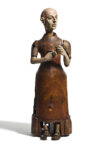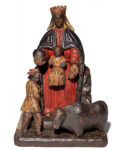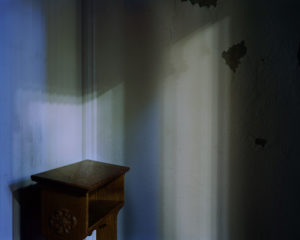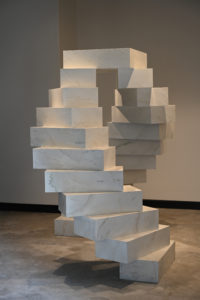Peter Manseau is a historian, novelist, and museum professional, serving as both Lilly Endowment Curator of Religion at the National Museum of American History and director of the Smithsonian’s Center for the Understanding of Religion in American History. Winner of the National Jewish Book Award, the American Library Association’s Sophie Brody Medal, the Ribalow Prize for Fiction, an NEH Public Scholar Fellowship, and an NEA Literature Fellowship, he received his doctorate in religion from Georgetown University, writes often for venues including the New York Times and the Washington Post, and lives with his family on a farm in Annapolis, Maryland.
Image: This interview is part of our curator’s corner feature, but you’re also a scholar and a writer of nonfiction and fiction. Can you talk a bit about how your sense of storytelling dovetails with how you communicate as a curator?
PM: Before I imagined being either a writer or a curator, I wanted to be an archaeologist. There was something magical to me in the idea of making contact with the past through objects pulled up from the ground. Probably as a result of that early interest, my writing has often focused on the material as a way of approaching invisible forces that shape our lives: memory, ideas, fear, hope. As a curator, I have a nearly mystical sense of the power of objects to open a portal between history and today, lives long ended and lives currently unfolding. As both a writer and a curator, I approach storytelling as a practice of organizing the experience of making contact.
Image: You recently curated an exhibition called Discovery and Revelation at the National Museum of American History. What sparked the concept for this exhibition? Were there specific objects you knew you had to secure for the show?
PM: Every project I take on seems born of lingering questions from the last. My first exhibit at the National Museum of American History was Religion in Early America, which told the story of religious freedom, religious diversity, and religious growth from the colonial period to 1830. The obvious question a timebound exhibit like that might pose is “And then what?” But I didn’t want to continue the museum’s examination of religion merely as a march through history. I wanted instead to dig into the why: Why think about religion in American history? The answer I was interested in exploring was that religion is one way people have approached the big questions of life, but of course it is not the only way. So the idea of presenting intersections of religion and science, as we do in Discovery and Revelation, was born of contextualizing a universal desire for greater understanding. We organized the exhibit around three questions: What is our place in the universe? What does it mean to be human? What do we owe each other? The point was not to answer these questions but to offer some ways throughout American history that answers had been sought. The objects I felt would most effectively present this spirit of exploration were things that had gone on journeys themselves—perhaps most especially a NASA flight manual that included the opening verses of the book of Genesis and that orbited the moon in 1968.

Automaton of a Friar, mid-sixteenth century. Spain. Wood and iron clockwork. 16 x 5 x 6 inches. Collection of the National Museum of American History. Included in the “What Does It Mean to Be Human?” section of the Discovery and Revelation exhibition.
Image: Do you think Americans understand these terms discovery and revelation in ways that differ from people in other nations or regions?
PM: I’ve certainly encountered an interesting American sense of ownership of both terms, perhaps beginning with the mythology that we live in a place that was “discovered” and continuing up through beliefs held by many throughout history that the United States has some connection to Revelation in the biblical sense. As an exhibit title, the pairing was chosen more for poetic reasons than as any kind of thesis statement. It may have been inspired by reflecting on the work of Charles Townes, the physicist and inventor whose work appears in the show. He played a role in the development of the laser and believed the insights he had were the result of both scientific discovery and divine revelation.
Image: You’re the first curator of religion at the Smithsonian. In what ways did religion tend to surface in museum exhibitions before your time? Have you observed any uneasiness among viewers when you bring religion to the forefront in your exhibitions?
PM: While I’m the first curator of religion at the National Museum of American History, there have been others with similar roles going back deep into the history of the Smithsonian. The first was Cyrus Adler, the director of the division of religion at the United States National Museum, as the Smithsonian was known when it was just one museum. Adler was a fascinating figure: a major player in American Jewish studies, he started his career as a professor of Semitic languages at Johns Hopkins University before serving the Smithsonian in a variety of roles. In Adler’s time, though he actively built a large Judaica collection along with religious objects from around the world, there was the unspoken assumption that all these diverse items were on display for the nation’s white Protestant majority. Today we operate with an understanding that religious difference does not exist just behind glass, within exhibitions, but is carried into museums by people of all faiths and no faith. It has been surprising to me how little uneasiness with this approach we have encountered.
Image: You’re designing a major new permanent exhibition on American religions for the museum. At what stage in that process are you? Are there certain objects you know will be touchstones?
PM: We are still nearly two years out from opening, but we have developed a concept that I think succeeds in taking an enormous story and making it accessible. In some ways having a subject as vast as “religion in America” provides its own useful constraints, because there is just no way to be comprehensive. Instead, we approach the topic episodically and thematically, hopefully helping visitors understand some of the many different meanings religion has had throughout the history of the United States. While we try to avoid announcing specific elements too early because they may change, we know that we are choosing objects and stories that can be viewed through a variety of lenses: How might a single object suggest to some religion’s role in inclusion and building community, but to others religion’s role in doing the opposite, letting those outside a community know that they do not belong? Seen this way, every object related to religion in America can tell a complex, multilayered story.
Image: Are there objects you would hesitate to put on exhibition because they might be considered too sacred, or perhaps too iconoclastic?
PM: We are attempting to include a range of objects that includes some that are obviously religious—items from houses of worship or widely recognizable practices, for example—along with other objects whose role in American religious history takes more effort to interpret and unpack. Our working assumption is that religion’s influence is everywhere; it’s not always obvious, but the subtle ways it shows up in culture are just as important to understand as the obvious ways, perhaps even more so.

Victor Martinez. El Camino Hood with Virgin of Guadalupe, 1959. New Mexico. Steel and enamel. 32¼ x 54 x 1 inches. Collection of the National Museum of American History.
Image: What examples of art do you envision utilizing in the permanent exhibition?
PM: Many of the objects will have mainly historical rather than artistic significance, but the museum also has collections of striking religious art we’ll likely draw upon. For example, the Teodoro Vidal Collection of Puerto Rican History includes a large number of beautiful santos (carved statues of Catholic saints) made from the eighteenth through the twentieth centuries. Yet while works like those show how one tradition approaches depicting the divine, I’m also interested in the human work behind it. In addition to carved figures that once were used devotionally, we may display some of the traditional tools used to craft them. A point I like to make is that religion isn’t found only in churches or on home altars, but in the workshops and artists’ studios where the material of religious practice is made.
Image: Your permanent exhibition is slated to be up for twenty years. If you feel comfortable speculating, what do you think viewers toward the end of that cycle might think about the exhibition, and about religious life in America more generally?
PM: I have a fairly broad understanding of “religion” that leads me not to put too much stock in studies showing its decline. Certainly some elements of religious belief and practice, such as regular attendance at worship services, or agreement with particular texts or teachings, can be tracked, quantified, and compared to similar metrics from other moments in history. But what people do or do not do for an hour on a particular day of the week strikes me as a woefully narrow definition of a category that should include the ways in which those same people contemplate the mystery of the universe and their place within it. One thing we hope to capture in the exhibition is that religion has meant many things to many people. Twenty years from now this will still be relevant and true—even if by then many who visit the museum have found entirely new ways of being religious that we cannot yet imagine.
Image: Are there objects and images from the January 6 insurrection that you think belong in an exhibition on American religion?
PM: Examining the religious dimensions of January 6 has been a significant part of my work almost since the day itself. As the first photos and videos of the attack began to appear online, I launched the Twitter hashtag #CapitolSiegeReligion, which became a way of tracking the many strands of religious influence on view that day. That early effort gathered a huge cache of images, which I and collaborators later collected through the online resource UncivilReligion.org (produced jointly by the Smithsonian and the University of Alabama’s department of religion). Beyond this digital imagery, there was a great deal of material culture of religion present among the insurrectionists: flags reading “God, Guns, and Trump” and “Jesus Is My Savior, Trump Is My President”; T-shirts and combat patches quoting biblical passages; portable speakers used by preachers and hymn singers who provided a soundtrack for the mob’s actions. Any of this could and should be used to tell a story that expresses why January 6 was a darkly significant day not just for American politics but for American religion as well.

Virgen de Monserrate, late eighteenth or early nineteenth century. Jayuya, Puerto Rico. Wood and paint. 13 x 9 x 9½ inches. Collection of the National Museum of American History. Gift of Teodoro Vidal.
Image: What other events in American history strike you as significant for the intersection of religion and visual culture that might not occur to most viewers?
PM: One of the things that keeps me interested in my job, and in religion generally, is that there’s no part of American culture that does not become entwined with religious imagery from time to time. Just look at sports, where it’s totally expected that a player will call upon divine forces or thank God for the ability to do what they’ve just done. This might be at a press conference or on the field, but it’s all a performance of religion, often on the largest of cultural stages. It may not be intended as art, but it plays a role in the ongoing generation of visual culture that can have surprising reverberations.
For example: A dozen or so years ago, when the Denver Broncos’ quarterback Tim Tebow was photographed kneeling in prayer with his head bowed after winning a game, it became a nationwide fad for others to have their pictures taken in a similar pose. They called it Tebowing, and it was such a big deal that Tebow even trademarked it. Was any of this art? Probably not as most would define it, but it led to thousands planning, posing for, making, and sharing images that otherwise would not exist.
And it’s important to note this kind of thing isn’t only relevant to sports fans. I’m not much of one myself, but I do take an interest in how religious aesthetics move through supposedly secular culture, with implications that are sometimes small and sometimes massive. In this case I’d argue that professional athletes engaging in devotional acts in front of millions has a way of making other athletic events seem, to many, an appropriate and perhaps even expected venue for religious expression. During the recent Supreme Court case involving a public high school football coach who wanted to pray with his team at midfield after games, I was not surprised to see him photographed in front of the court holding a football and kneeling in the exact pose Tim Tebow made famous. In sports, as in so much of American life, the visual culture of religion provides a frame that shapes experience.








